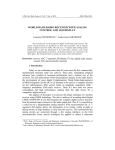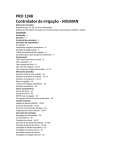Download 8T49N282 Evaluation Board User Guide
Transcript
8T49N282 Evaluation Board User Guide USER GUIDE Introduction The 8T49N282I evaluation board is designed to help the customer evaluate the IDT8T49N281, IDT8T49N282, and IDT8T49N283 devices, the latest additions to IDT's 3rd generation Universal Frequency Translator family. When the board is connected to a PC running IDT Timing Commander™ software through USB, the device can be configured and programmed to generate frequencies with best-in-class performances. Contents The 8T49N282 rev. D evaluation board ships with the following: • 1 – 8T49N282 Evaluation Board • 1 – USB Cable Requirements 1. PC Requirements: • IDT Timing Commander software installed. • USB 2.0 interface. The evaluation board USB module is not compatible with USB 3.0. If using a computer with high speed USB ports, please check if there's a standard USB 2.0 port available for use. The hardware drivers are automatically installed during the Timing Commander installation. • • • • • Windows XP SP3 or later. Processor: Minimum 1GHz. Memory: Minimum 512MB, recommended 1GB. Available Disk Space: Min 600MB (1.5GB 64bit), recommended 1GB (2GB 64bit) Network access during installation if the .NET framework is not currently installed on the system. 2. Power Supply with 3.3V and 1000mA rating 3. Three banana plug cables to connect the power supply to the board. Quick Start: Powering Up the Board (1) Set 3.3V supply current limit to 500mA. (2) Remove all output terminations. (3) Set Dip Switch selectors to the middle position. (4) Connect a cable from a PC to the USB port. (5) Connect VEE to the black GND jack. (6) Connect 3.3V to VCC_J and VDDO_J. (7) Power on the Power Supply. (8) Press the Reset Button. Once correct operation is verified, set the power supply limit for the number of outputs to be active. The USB port must be powered by the PC in order to have the correct I2C bus voltage levels. The board ships with a 38.88MHz crystal and will have a default frequency of 155.52MHz on Q0. If all outputs are unterminated, current should measure ~256mA with 3.3V on VCC_J and VDDO_J. If all outputs are terminated, current should measure ~262mA. When evaluating performance with the default hardware configuration, it is recommended that all active outputs be terminated 50ohms to VEE by either terminator plugs or an instrument. REVISION A 03/14/14 1 ©2014 Integrated Device Technology, Inc. 8T49N282 EVALUATION BOARD USER GUIDE Board Overview Use the following diagram to identify: power supply jacks, USB connector, input and output SMA connectors, reset button, EEPROM, etc. Figure 1. Evaluation Board Top View REVISION A 03/14/14 2 8T49N282 EVALUATION BOARD USER GUIDE Legend–Evaluation Board Top View Inputs CLK0_S Clock 0 sense lines. CLK0 Clock 0 input lines. Can be configured for differential or single-ended input. CLK1_S Clock 1 sense lines. CLK1 Clock 1 input lines. Can be configured for differential or single-ended input. CLK2 Clock 2 input lines. Can be configured for differential or single-ended input. CLK3 Clock 3 input lines. Can be configured for differential or single-ended input. Outputs Q0 Output Q0. Can be a differential pair or two individual single-ended outputs. Q1 Output Q1. Can be a differential pair or two individual single-ended outputs Q2 Output Q2. Can be a differential pair or two individual single-ended outputs. Q3 Output Q3. Can be a differential pair or two individual single-ended outputs. Q4 Output Q4. Can be a differential pair or two individual single-ended outputs. Q5 Output Q5. Can be a differential pair or two individual single-ended outputs. Q6 Output Q6. Can be a differential pair or two individual single-ended outputs. Q7 Output Q7. Can be a differential pair or two individual single-ended outputs. Other A Dip Switch for DC control signals (CLK_SEL, PLL_BYPASS, etc) B VCCO_J C VCC_J D GPIOs E RESET F IDT8T49N282 – the device to be evaluated G USB connector H EEPROM – AT24CO4C J Ground Jack REVISION A 03/14/14 3 8T49N282 EVALUATION BOARD USER GUIDE Figure 2. Evaluation Board Bottom View Legend–Evaluation Board Bottom View X1 3.2 x 2.5 mm SMD Fox-603-38.88-4 Crystal REVISION A 03/14/14 4 8T49N282 EVALUATION BOARD USER GUIDE Schematics The following figures are schematics that are applicable to specific sections of this User Guide. The complete schematics are available in a separate document. Figure 3. Inputs Schematic REVISION A 03/14/14 5 8T49N282 EVALUATION BOARD USER GUIDE Figure 4. Output Termination Schematic REVISION A 03/14/14 6 8T49N282 EVALUATION BOARD USER GUIDE Figure 5. Crystal Interface Schematic REVISION A 03/14/14 7 8T49N282 EVALUATION BOARD USER GUIDE Figure 6. EEPROM/I2C Schematic Figure 7. DC Control Schematic REVISION A 03/14/14 8 8T49N282 EVALUATION BOARD USER GUIDE Figure 8. VCCO Power Filtering REVISION A 03/14/14 9 8T49N282 EVALUATION BOARD USER GUIDE Figure 9. VCC Filtering J6 V C C _J VC C A _PLL0 BLM18B B221SN 1D C 15 0. 1u VC C _J T p y 9 5 ~ mA T p y 9 5 ~ mA C 17 10uF C 11 10uF C 13 0. 1u C 16 10uF C 18 0. 1u V C C A_66 VC C A _PLL0 F B2 C 12 10u C 14 0. 1u GN D V C C A_70 VC C A_P LL1 F B10 V C C A_19 C 26 10u C 65 10uF C 27 0. 1u B LM18B B221SN 1D C 61 0.1u C 62 10uF C 66 10u C 63 0. 1u C 67 0. 1u F B18 J14 VC C V CC VC C A_P LL1 GN D GN D V C C A_71 V C C A_20 C 42 10u BLM18B B221SN 1D C 193 0. 1u C 192 10uF C 119 10uF C 76 10u C 120 0.1u C 43 0. 1u C 77 0. 1u GN D GN D GN D V C C A_72 V C C A_21 C 53 10u C 55 0. 1u Co ls e t o h t e DU T C 87 10u VC C O0 VC C O1 VC C O2 C 88 0. 1u V C C O3 GN D C 103 0.1u C 104 0. 1u C 105 0. 1u C 106 0.1u GN D GN D GN D GN D VC C O4 VC C O5 VC C O6 V C C O7 GN D C 89 10u C 107 0.1u C 108 0. 1u GN D C 109 0. 1u GN D GN D GN D GN D 10 J5 C 90 0. 1u C 110 0.1u GN D REVISION A 03/14/14 J4 GN D VC C A _25 GN D 8T49N282 EVALUATION BOARD USER GUIDE Board Power Supply Core Voltages The core voltage includes a digital voltage VDD and an analog voltage VDDA. Both core voltages are powered by the external bench power supply connected to J6 (VCC_J). See Figure 9 for details Output Voltages VDDO_J (J1) supplies the global voltage for the outputs and can be biased by the external power supply at 1.8V (all outputs LVCMOS), 2.5V, or 3.3V. Mixed Voltage Operation This board provides the option to operate the outputs with a mixed combination of output voltages. Refer to Figure 8 for a complete view of the VCCO schematic. Each VCCOx has a 0 resistor that connects it to the global VCCO_J power rail. This resistor can be removed and the voltage can be provided using the test point. For example, the schematic below can be configured so that Q0 (VCCO0) operates at 2.5V and Q4 LVCMOS (VCCO4) operates at 1.8V as follows: 1) Connect 2.5V to J1 (VCCO_J). 2) Remove R146. This isolates VCCO4 from global VCCO_J. 3) Solder a wire onto test point VCCO4 and bias with a 1.8V supply. Figure 10. Mixed Output Voltage Operation REVISION A 03/14/14 11 8T49N282 EVALUATION BOARD USER GUIDE Input Configuration The inputs are configured with an ac-coupling termination scheme. This scheme allows flexibility for either differential or single-ended inputs. The default configuration is as follows: Table 1: Default Input Configuration Input Default Termination Sense Lines CLK0 50ohms to ground, ac-coupled into the device Use SMAs J15/J18 for observation of the input signal CLK1 50ohms to ground, ac-coupled into the device Available but not connected. Populate R47 and R59 to observe input signal on SMAs J23/J30 CLK2 50ohms to ground, ac-coupled into the device Not available CLK3 50ohms to ground, ac-coupled into the device Not available Differential Input Connect the input signal to CLKx and nCLKx. For CLK0, the CLK0_S and nCLK0_s sense lines are available for observation of the signal. They can be connected with 50ohm impedance cables to an oscilloscope with 50ohm termination, otherwise, they should be terminated with 50ohm plugs in order prevent reflections. Single-ended Input Connect the input signal to CLKx and float nCLKx. For CLK0, connect CLK0_S with a 50ohm impedance cable to an oscilloscope with 50ohm termination or terminate with a 50ohm plug. Input Signals below 1MHz For slow-frequency signals below 1MHz, we recommend that the coupling capacitors for the corresponding input be replaced with zero-ohm resistors and that the signal input dc-offset be set so that it meets the device's Vcmr requirements. Refer to Figure 3 to locate the components listed below. Table 2: Input Termination Schemes Signal Frequency AC-coupling capacitors: CLK0 (C121, C122) CLK1 (C130,C131) CLK2 (C150,C151) CLK3 (C160,C161) Input Signal DC Offset >1MHz 1µF Don't care <1MHz Must meet datasheet Vcmr specs REVISION A 03/14/14 12 8T49N282 EVALUATION BOARD USER GUIDE Output Configuration The outputs are ac-coupled, allowing for maximum flexibility for observation of the output whether configured for LVPECL, LVDS, or LVCMOS levels. The default termination scheme can be used to measure either of the three output level-types but is not optimal. The optimal termination circuits are tabulated below. Refer to Figure 4 to locate the components listed below. Table 3: Termination Outputs for Q0 Signal Type 180 ohm pull-down: R39, R40 Series capacitors: C123, C125 Resistor Network: R35, R36, R41, R42 LVPECL (Default) Installed 1µF Not installed LVCMOS Not installed 33 ohm Not installed LVDS Not installed 1µF Not installed Table 4: Termination Outputs for Q1 Signal Type 180 ohm pull-down: R43, R44 Series capacitors: C124, C126 Resistor Network: R37, R38, R45, R46 LVPECL (Default) Installed 1µF Not installed LVCMOS Not installed 33 ohm Not installed LVDS Not installed 1µF Not installed Table 5: Termination Outputs for Q2 Signal Type 180 ohm pull-down: R60, R61 Series capacitors: C133, C138 Resistor Network: R52, R53, R62, R63 LVPECL (Default) Installed 1µF Not installed LVCMOS Not installed 33 ohm Not installed LVDS Not installed 1µF Not installed Table 6: Termination Outputs for Q3 Signal Type 180 ohm pull-down: R64, R65 Series capacitors: C134, C139 Resistor Network: R54, R55, R66, R67 LVPECL (Default) Installed 1µF Not installed LVCMOS Not installed 33 ohm Not installed LVDS Not installed 1µF Not installed Table 7: Termination Outputs for Q4 Signal Type 180 ohm pull-down: R77, R78 Series capacitors: C143, C145 Resistor Network: R68, R69, R79, R80 LVPECL (Default) Installed 1µF Not installed LVCMOS Not installed 33 ohm Not installed LVDS Not installed 1µF Not installed REVISION A 03/14/14 13 8T49N282 EVALUATION BOARD USER GUIDE Table 8: Termination Outputs for Q5 Signal Type 180 ohm pull-down: R82, R83 Series capacitors: C144, C146 Resistor Network: R70, R71, R81, R84 LVPECL (Default) Installed 1µF Not installed LVCMOS Not installed 33 ohm Not installed LVDS Not installed 1µF Not installed Table 9: Termination Outputs for Q6 Signal Type 180 ohm pull-down: R94, R95 Series capacitors: C154, C157 Resistor Network: R90, R91, R96, R97 LVPECL (Default) Installed 1µF Not installed LVCMOS Not installed 33 ohm Not installed LVDS Not installed 1µF Not installed Table 10: Termination Outputs for Q7 Signal Type 180 ohm pull-down: R98, R99 Series capacitors: C155, C158 Resistor Network: R92, R93, R100, R101 LVPECL (Default) Installed 1µF Not installed LVCMOS Not installed 33 ohm Not installed LVDS Not installed 1µF Not installed As noted, the 4-resistor network is not installed in Tables 3~10 because an oscilloscope with internal 50 termination is utilized for signal termination and measurement. If a dc-coupled, stand-alone LVPECL output is needed (without oscilloscope connections), the 4-resistor network needs to be installed accordingly. The table below provides the configuration for Q0: Table 11: Resistor Termination Outputs for LVPECL for Q0 Signal Type 180 ohm pull-down: R39, R40 Series capacitors: C123, C125 Resistor Network: R35, R36, R41 R42 LVPECL (Default) Not installed 0 ohm R35=R36=125ohm R41=R42=84ohm Output signals below 1MHz For slow-frequency output signals below 1MHz, we recommend that the 1µF ac-coupling capacitors be replaced with 0ohm resistors and that the correct terminations be provided at the receiver. REVISION A 03/14/14 14 8T49N282 EVALUATION BOARD USER GUIDE EEPROM Boot The evaluation board ships with an IDT8T49N282-997device, which will attempt to boot from the EEPROM at power-up. By default, the EEPROM boot is not enabled on the board. If use of the EEPROM boot is required, there are three options to enable this mode. 1) No Rework Option. This option will enable the EEPROM boot and does not require any soldering. This sequence must be performed each time the EEPROM needs to be reloaded into the device. a. Hold down the reset button. b. Unplug and then plug in the USB cable. c. Release the reset button. 2) Rework Option. This option will enable the EEPROM boot but requires soldering. It does not require continually unplugging/plugging-in the USB cable for reloading of the EEPROM into the device. a. Remove LD10 or replace R156 with a 1Kohm resistor. (See Figure 6). b. Power up the board with USB cable connected. c. Press and release the reset button. 3) Stand-Alone Use. Sometimes it's necessary to evaluate the device inside a temperature chamber, a system rack, or a Faraday cage where a USB connection to the device is impractical. For such cases contact IDT for further support. For details on how to program the EEPROM, please refer to document How to Program the 8T49N28x EEPROM. DC Controls The Dip Switch has three settings: 0V, Float, and VCC. This board ships with all switches in the Float (middle) position. Refer to Figure 1, label "A" for the location of the Dip Switch. REVISION A 03/14/14 15 8T49N282 EVALUATION BOARD USER GUIDE Crystal Interface By default, a 3.2x2.5mm SMD 38.88MHz crystal is installed on bottom side of the board. It provides the reference frequency for the device. This board supports other options for the XTAL_IN reference. If using one of the other options, the crystal on X1 must be removed. 1) Through-hole crystal. With this option, the device can be evaluated with different crystals without the need to solder each time the crystal is replaced: a. Remove the crystal from X1 on bottom-side of the board. (See Figure 2, "X1" for location of the component.) b. Solder in crystal sockets into the holes labeled X2. (See Figure 11 below for location of the component.) c. Place a crystal into the socket. Figure 11. Crystal Interface PCB 2) Crystal Overdrive. With this option, the device can be evaluated with different sources, such as frequency generators, XO's, or other devices. Refer to Figure 5 and Figure 10 for identification of the components mentioned below. a. Remove the crystal from X1. (See Figure 2, "X1" for location of the component.) b. Populate SMA J56. c. Solder a 1µF capacitor onto C164. Note: the input must be ac-coupled d. R139 may be populated with a 50ohm resistor for input sources requiring such termination. e. R137 must be populated. It may be a 0ohm resistor for input sources or 33ohms for CMOS inputs. REVISION A 03/14/14 16 8T49N282 EVALUATION BOARD USER GUIDE Corporate Headquarters Sales Tech Support 6024 Silver Creek Valley Road San Jose, CA 95138 USA 1-800-345-7015 or 408-284-8200 Fax: 408-284-2775 www.IDT.com email: [email protected] 480-763-2056 DISCLAIMER Integrated Device Technology, Inc. (IDT) and its subsidiaries reserve the right to modify the products and/or specifications described herein at any time and at IDT’s sole discretion. All information in this document, including descriptions of product features and performance, is subject to change without notice. Performance specifications and the operating parameters of the described products are determined in the independent state and are not guaranteed to perform the same way when installed in customer products. The information contained herein is provided without representation or warranty of any kind, whether express or implied, including, but not limited to, the suitability of IDT’s products for any particular purpose, an implied warranty of merchantability, or non-infringement of the intellectual property rights of others. This document is presented only as a guide and does not convey any license under intellectual property rights of IDT or any third parties. IDT’s products are not intended for use in applications involving extreme environmental conditions or in life support systems or similar devices where the failure or malfunction of an IDT product can be reasonably expected to significantly affect the health or safety of users. Anyone using an IDT product in such a manner does so at their own risk, absent an express, written agreement by IDT. Integrated Device Technology, IDT and the IDT logo are registered trademarks of IDT. Product specification subject to change without notice. Other trademarks and service marks used herein, including protected names, logos and designs, are the property of IDT or their respective third party owners. Copyright 2014. All rights reserved.
























